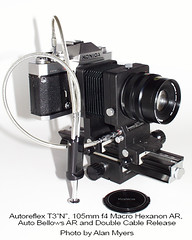Konica
See also Konica Minolta.
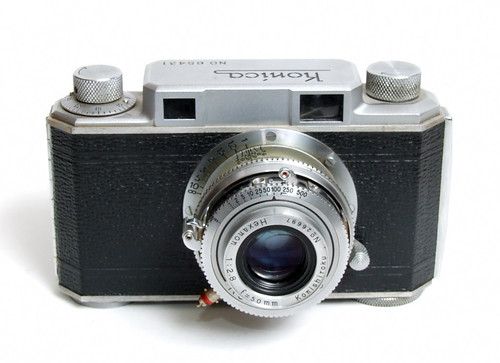
|
| the "Konica" rangefinder image by Süleyman Demir (Image rights) |
Konica was the oldest Japanese photographic company until it stopped camera manufacturing in 2006.
Contents
- 1 History
- 2 Cameras
- 3 Lenses
- 4 Accessory Items
- 4.1 Enlarging lenses
- 4.2 Macro and close-Up, rangefinder and viewfinder cameras (fixed lens)
- 4.3 Macro and close-Up, 35mm SLRs, Bayonet Mount I (early)
- 4.4 Macro and close-Up, 35mm SLRs, Bayonet Mount II (K/AR)
- 4.5 Flash: bulb holder & electronic types
- 4.6 35mm slide projectors
- 4.7 Other accessories
- 4.8 Lens adapters
- 5 Leaf shutters
- 6 Special and Military Items
- 7 Film and chemistry
- 8 Imported products
- 9 Notes
- 10 Bibliography
- 11 Links
History
The company originated as a drugstore called Konishi-ya Rokubei Ten (小西屋六兵衞店), operated by Sugiura Rokuemon V (5代杉浦六衞門).[1] His son Sugiura Rokusaburō (杉浦六三郎) entered the company and expanded its activities by selling photographic products beginning in 1873.[2] Sugiura Rokusaburō took the name of Sugiura Rokuemon VI (6代杉浦六衞門) in 1879, and the company was subsequently renamed Honten Konishi Rokuemon (本店小西六右衞門), abridged as Konishi Honten (小西本店).[3] Early cameras were produced by artisan subcontractors, such as Hasegawa Toshinosuke (長谷川利之助) and Tōjō Kamejirō (東条亀次郎).[4] The company founded a manufacturing branch called Rokuoh-sha (六桜社) in 1902, and released the Cherry in 1903, the first Japanese camera to have a brand name.[5] The factory of Hasegawa Toshinosuke became the wood workshop of Rokuoh-sha in 1906. Most of the camera production was still assumed by other subcontractors, many of which were merged into Rokuoh-sha in 1919.[6]
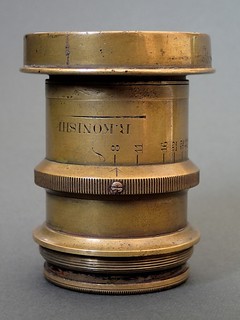
|
| Early R Konishi Rapid Rectilinear 5-inch f/8 image by Dirk HR Spennemann (Image rights) |
The company became G.K. Konishiroku Honten (合資会社小西六本店) in 1921. The character roku (六) is a double allusion to Sugiura Rokuemon VI: it means "six" and is the first character of Rokuemon. The logo of the company shows this character inside a cherry blossom. Konishiroku founded the Konishi College of Photography (小西写真専門学校) in Tokyo in 1923.[7] It introduced the Pearlette in 1925, which would be the first mass-produced Japanese camera, under the supervision of Yamada Kōgorō (山田幸五郎).[8] In 1929, it launched the Sakura rollfilm, the second rollfilm brand in Japan.[9] In 1931, it released the first Japanese camera lens commercially available, called Hexar; this name was again formed after the number "six".
The company changed status again in 1936 and became K.K. Konishiroku (㈱小西六). The cameras and lenses were still marked as made by the manufacturing branch Rokuoh-sha. In April 1943, the retail and wholesale activities were stopped[10] and the company was reorganized as Konishiroku Shashin Kōgyō K.K. (小西六写真工業㈱), based in Yodobashi, Tokyo;[11] the name Rokuoh-sha was abandoned around that time. The company name was translated after the war as Konishiroku Photo Industry Co., Ltd.
The name Konica was originally that of a 35mm rangefinder model presented in 1947. Similarly to "Leica", "Yashica" and many others, the name "Konica" was constructed by abbreviating the name of the manufacturer and attaching "ca" (for "camera") as a suffix.[12]
In August 1960, Konishiroku bought all the shares of Taisei Kōki, a minor camera maker in Itabashi, Tokyo.[13] This moved to Tsuru, in the prefecture of Yamanashi, in 1968, and became K.K. Yamanashi Konica (㈱山梨コニカ) in 1972, then K.K. Konica Denshi (㈱コニカ電子, Konica Electronics) in 1983, and is today Konica Minolta Electronics Co., Ltd.[13]
The company as a whole changed its name to Konica Corporation only in 1987,[14] although its US branch did so earlier (in 1984).[15] Konica merged with Minolta in 2003 and became Konica Minolta, which would stop the production of cameras in 2006.
Cameras
Digital

|
| image by Woodenship (Image rights) |
- Konica Revio C2
- Konica DG-1 / DG-2 / DG-3Z
- Konica Digital Revio KD-100
- Konica Digital Revio KD-200Z / KD-300Z / KD-400Z / KD-500Z
- Konica Digital Revio KD-310Z / KD-410Z / KD-510Z
- Konica Digital Revio KD-220Z / KD-420Z
- Konica KD-25
- Konica KD-3000
- Konica Digital Revio KD-3300
- Konica KD-4000
- Konica e-mini / e-mini m
- Konica Q-EZ
- Konica Q-M100
- Konica Q-M100V
- Konica Q-M200
- Konica Q-Mini
Still Video
17.5mm film
35mm film
SLR, Konica Bayonet Mount "I"

|
| Konica F image by Alan Myers (Image rights) |
The mount is also called Konica "F-mount" or Konica "Early Mount".
- Koniflex 35, prototype (1957)
- Konicaflex, prototype (1959)
- Konica F (1960)
- Konica FS
- Konica FS-W
- Konica FP
- Konica FM
SLR, Konica Bayonet Mount II
The mount is also called "AR-mount" or "K/AR Mount".

|
| Konica FT-1 image by Martin Taylor (Image rights) |
- Konica Auto-Reflex and Autorex
- Konica Auto-Reflex P and Autorex P
- Konica Autoreflex T and Autoreflex FTA
- Konica Autoreflex W
- Konica Autoreflex A
- Konica Autoreflex T"2" and Autoreflex FTA"2"
- Konica Autoreflex A"2"
- Konica Autoreflex A1000
- Konica Autoreflex T3
- Konica Autoreflex A3
- Konica Autoreflex T3N or NT3 or "New" T3
- Konica Autoreflex TC (ACOM-1)
- Konica Autoreflex T4
- Konica FS-1
- Konica FC-1
- Konica FP-1
- Konica FT-1 and FT-1 Pro Half
- Konica TC-X
SLR, fixed mount
Rangefinder, interchangeable lens
Rangefinder, fixed lens

|
| Konica II by rebollo_fr (Image rights). |
- Konica (I or Standard) (Based on Rubikon/Rubicon prototype)
- Konica II, IIA, IIB, IIBm, IIF
- Konica III, IIIA, and IIIM
- Konica Auto S
- Konica Auto S1.6
- Konica Auto S2, Auto S2 "New", and Auto S2 "EL"
- Konica Auto S3 (1973, Konica C35 FD in Japan)
- Konica Auto SE Electronic
- Konica C35
- Konica C35 Automatic (C35 Flashmatic in Japan)
- Konica EE-Matic
- Konica EE-Matic Deluxe
- Konica EE-Matic Deluxe 2
- Konica EE-Matic Deluxe F
- Konica EE-Matic Deluxe, "New" Deluxe
- Konica EE-Matic S
- Konica Electron
- Konica J
- Konica S
- Konica S II
- Konica S III
Viewfinder, fixed lens
| ||
|
- Konica A4 / Big Mini (1989)
- Konica AF3 and AF3-D
- Konica AiBORG
- Konica Big Mini
- Konica Big Mini F (35mm f/2.8)
- Konica Big Mini Jr BM-20
- Konica Big Mini SR BM-100
- Konica Big Mini EX BM-101
- Konica Big Mini BM-201
- Konica Big Mini HG BM-300
- Konica Big Mini BM-301
- Konica Big Mini BM-302
- Konica Big Mini BM-311Z
- Konica Big Mini Ai BM-411Z
- Konica Big Mini BM-510Z
- Konica Big Mini TR BM-610Z
- Konica Big Mini Neo-R
- Konica Big Mini Standa
- Konica C35 V (C35E&L in Japan)
- Konica C35 AF and AF2 ("Jasupin", "Jasupin Super" and AF2-D)
- Konica C35 EF ("Pikkari") and C35 EF N (New) and EF-D (Date)
- Konica C35 EF3
- Konica C35 EFJ (aka pop)
- Konica C35 EFP
- Konica C35 MF and C35 MF-D

|
| Konica C35 EFP image by AWCam (Image rights) |
- Konica Dr.Finder EFP-30
- Konica EFP2
- Konica EFP3
- Konica EFP-20
- Konica EU-mini
- Konica Genba Kantoku / Off-road
- Konica Genba Kantoku (1988)
- Konica Genba Kantoku DD (1989)
- Konica Genba Kantoku 28 (1990)
- Konica New Genba Kantoku (1992)
- Konica Genba Kantoku 28WB (1994) / 28WB ECO
- Konica Genba Kantoku 35WB (1994)
- Konica Genba Kantoku 28HG (panorama) (1994)
- Konica Genba Kantoku Zoom 28-56 (1996)
- Konica Hexar
- Konica Jump (weatherproof)
- Konica Jump Auto (weatherproof)
- Konica Jump Auto II (weatherproof)
- Konica Kanpai
- Konica L
- Konica Lexio 70
- Konica Lexio 115
- Konica Manbow (weatherproof)
- Konica Manbow Woo (weatherproof)
- Konica Mermaid
- Konica MG
- Konica MG and MG-D
- Konica MR.70 LX
- Konica MR.70
- Konica MR.640
- Konica MS-40
- Konica MT-100
- Konica MT-7, MT-9 and MT-11 "Multi"
- Konica pop (aka EFJ)
- Konica pop-10
- Konica pop-AF
- Konica POP AF300 and POP Panorama
- Konica pop-AF 800
- Konica pop-AF 880
- Konica POP EF-5
- Konica pop-EF 70
- Konica pop-EF 80
- Konica POP EFP-8
- Konica pop Mini
- Konica pop Super
- Konica Snap
- Konica Top's AF-300
- Konica Top's AF-300SP
- Konica Tomato

|
| Z-up 110 VP image by Andrys Stienstra (Image rights) |
- Konica Z-up
- Konica Z-up 28W
- Konica Z-Up 60
- Konica Z-up 60E (1999)
- Konica Z-up 70 VP (1999)
- Konica Z-up 70 Super
- Konica Z-up 80 / Z-up 80 RC
- Konica Z-up 110 Super
- Konica Z-up 110 VP
- Konica Z-up 115e
- Konica Z-up 118
- Konica Z-up 120VP (1999)
- Konica Z-up 125E
- Konica Z-up 135 Super
- Konica Z-up 140 Super
- Konica Z-up 150 (VP)
- Konilette "I"
- Konilette "II"
- Konilette "III"
- Konilette 35
Half frame
Disposable / Single Use
Konica commenced manufacturing single-use cameras in 1987. As a major film manufacturer, Konica, like Agfa and Kodak, had to include disposable cameras in its range after Fuji had pioneered the concept in 1986. Over time, Konica developed a number of specialised disposables not offered by other manufacturers, notably the Waiwai / Superwide with 17mm lens and mirror on the front.

|
| Black&White 18exp. by Capt Kodak image by Steve Harwood (Image rights) |
- 3D (camera with 3 lenses and a flash, loaded with LV400 film, 16 exp.)
- Black & White (2002) (loaded with 400 ISO black & white film, 18 exp)
- Film-In 24+3 (<2000) (loaded with Centuria 400, 27 exp)[16]
- also produced as commemorative cameras for events, such as the Tour de France 2005
- Film-In 27 Flash (<2000) (loaded with Centuria 400, 27 exp) [17]
- Film-In-Mini Konica Black-and-White (Torikkiri Konica Shirokuro) (April 1995)[18]
- Film-In Mini (<2001) (loaded with Centuria 400, 24 exp)
- Film-In Neo (2001) (loaded with Centuria 400, 27 exp)
- Film-In Neo 800 Flash (2000) (loaded with Centuria 800, 27 exp)
- Film-In Neo Super Outdoor Jour (2003) (loaded with Centuria 400, 27 exp) [19]
- Film-In Neo Super Flash (2003) (loaded with Centuria 400, 27 exp)
- Film-In Centuria Super Flash (2003) (loaded with Centuria 800, 27 exp)[20]
- Film-In Panorama 12 (loaded with Centuria 400, 12 exp)
- Film-In Superwide (17mm lens) (loaded with Centuria 800, 12 exp) (=WaiWai distributed in USA)
- Film-In Waterproof 24+7 (loaded with 400ASA, 27 exp). Essentially a Film-In 24+3 in a plastic housing
- also available with marketing imprints, eg Coca-Cola
- Issimo (1998) (loaded with APS Film ISO400, 25 exp), lens: 24/8.5 [21]
- Issimo Mirror Type APS Film ISO400 (1998)[22]
- Torikkiri Mini (April 1992)
- Torikkiri Motto Mini Flash Sepia (1997),
- Torikkiri Konica AD flash (1996, 25 exp)[23]
- Torikkiri Konica MINI 2 Flash (1996, 24 exp)[24]
- Torrikiri Konica Cho-Mini
- Torikkiri MiNi Goody (July 1999)[25]
- Torikkiri MiNi Goody SUPER (September 2000)[26]
- Torikkiri Konica Photo Hime with flash and attachable soft focus adapter (June 1998) (24 exp)
- Torikkiri Waterproof (loaded with 400ASA, 27 exp)
- WaiWai (17mm lens) (loaded with Centuria 800, 12 exp)[27] (single use but can be hacked for reloading[28])
Unperforated 35mm film
- Record, 1926
- Konilette (blue green plastic top cover)
- Konilette II (metal top cover)
- Konilette IIM (built-in meter)
126 film
- Konipak 100 / Sakurapak 100
- Konipak 100X
- Konipak 300 / Sakurapak 300
- Auto S 261
110 film
APS film
- Konica BM-S 100 "Super Big Mini"
- Konica BM-S "super Big Mini" 630 Z
- Konica Revio
- Konica Revio II
- Konica Revio CL
- Konica Revio Z2
- Konica Revio Z3
Disc film
Instant film
120 film
4.5×6cm
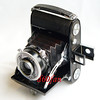
|

|

|
| Semi Pearl | Pearl IIIMX | Pearl IV |
- Semi Pearl, 1938
- Pearl (I) and RS, 1949
- Pearl II and IIB, 1951
- Pearl III, IIIMX and IIIL, 1955
- Pearl IV, 1958
- Konica SF, prototype SLR, 1967 or 1968
6×6cm
- Sakura-flex, prototype TLR, 1940
- prototype SLR, before 1951
- Koniflex, TLR, 1952
6×7cm
- Koni-Omega, rangefinder
- Koni-Omegaflex, twin lens camera
6×9cm

|
| Year-Eight Pearl |
- Pearl No.3, for plates and rollfilm, 1916
- Pearl No.2:
- wooden, 1923
- metal, 1927
- Sakura (box), 1931
- Pearl (self-erecting):
- Year-Eight Pearl, 1933
- Rangefinder-equipped Pearl, 1936
- Luxury Pearl, 1937
127 film

|

|

|
| Pearlette | Baby Pearl | Sakura box, 4×6.5cm |
- Pearlette, 4×6.5cm folder, 1925
- Special Pearlette, 4×6.5cm folder, 1929
- Sakura (box), 4×6.5cm box, 1931
- Baby Pearl, 3×4cm folder, 1934
- B Pearlette, 4×6.5cm folder, 1935
- Sakura (bakelite), 4×5cm collapsible, 1937
118 or 122 film

|
| Pearl No.3, 8×10.5cm |
- Sakura Palace (8×10.5cm, 1908)
- Pearl (for plates and rollfilm):
- Pearl Hand Camera No.3 and No.4 (8×10.5cm, 1909)
- Minimum Pearl (8×10.5cm, 1911)
- Pearl Kodak (8×10.5cm and 8×14cm, 1914)
- Pearl No.3 and No.4 (8×10.5cm and 8×14cm, 1914)
- Special Pearl (8×10.5cm and 8×14cm, 1913)
Plates / Plate film
Studio and Field cameras
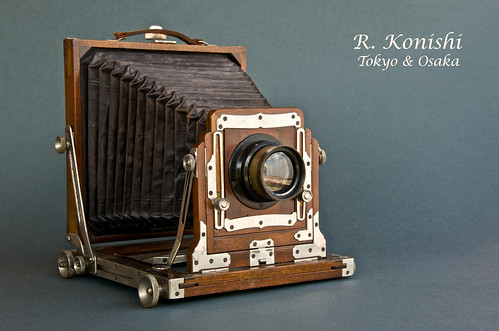
|
| Special Thin Field Camera image by Dirk HR Spennemann (Image rights) |
- Extra Portable Cameras (1894) (番外携帯用暗函)[29]
- Hei Field Camera (1894) (丙號携帯用暗函)[29]
- Hei Studio Camera (1894) (丙號室内用暗函)[29]
- Kō Field Camera (1894) (甲號携帯用暗函)[29]
- Kō Studio Camera (1894) (甲號室内用暗函)[29]
- Tei Studio Camera (1897) (丁號室内用暗函)[29]
- Improved Special Field Camera (1897) (改良特別製携帯用暗函)[29]
- Otsu No.1 Field Camera (1894) (乙號第一號携帯用暗函)[29]
- Otsu No.2 Field Camera (1894) (乙號第三號携帯用暗函)[29]
- Otsu No.3 Field Camera (1894) (乙號第二號携帯用暗函)[29]
- Special Studio Camera (1894) (特別製室内用暗函)[29]
- Special Thin Field Camera (1894) (特別製薄形携帯用暗函)[29]
- Stereoscopic Camera (1894) (雙眼写真用暗函)[29]
Magazine or detective cameras
- Cherry (5.5×8cm or 8×10.5cm, 1903)
- Champion (8×10.5cm, 1904)
- Sakura Army (8×10.5cm, 1907)
- Sakura Navy (8×10.5cm, 1907)
- Sakura Honor (8×10.5cm, 1907)
The Midg is presented by some sources as a Konishi product, copy of the Butcher model of the same name; however this is unsure and it might be a camera imported by Konishi instead.
Folders
- Sakura Prano (8×12cm and 12×16.5cm, 1907)
- Sakura Palace (8×10.5cm, 1908)
- Noble (8×14cm or 12×16.5cm, 1908)
- Idea (8×12cm and 12×16.5cm, 1909)
- Idea A series:
- Pocket Idea A1, Idea A1 and Idea A (8×10.5cm, 1909–23)
- Idea A1 and Idea A (5.5×8cm, 1915–23)
- Idea B series:
- Pocket Idea B and Idea B (8×10.5cm, 1909–23)
- Idea B and Idea Snap (5.5×8cm, 1915–23)

|
| Lily image by Dirk HR Spennemann (Image rights) |
- Lily (original) (8×10.5cm, 1909)
- Lily (horizontal):
- Lily No.2 and Special Lily (5.5×8cm, 8×10.5cm and 8×14cm, 1916–22)
- Neat Lily and Special Lily (5.5×8cm and 8×10.5cm, 1923–30)
- Idea No.1 (5.5×8cm, 6.5×9cm and 8×10.5cm, 1923–30)
- Idea (metal models)
- Idea (6.5×9cm and 8×10.5cm, 1930)
- Year-Eight Idea (6.5×9cm, 1933)
- Lily (metal and tropical models)
- Lily (6.5×9cm and 8×10.5cm, 1930)
- Tropical Lily (6.5×9cm and 8×10.5cm, 1931)
- Lily, upgraded (6.5×9cm and 8×10.5cm, 1933–4)
- New Lily (6.5×9cm, 1937)
- Military Lily (8×10.5cm, c.1937)
- Ohca (6.5×9cm, 1935)
Stereo folders
- Sakura Binocular Prano (8×12cm, 1907)
- Idea Binocular (8×12cm, 1909)
Strut folders
- Minimum Idea (5.5×8cm, 1911)
- Korok (5.5×8cm, 1914)
- Idea Spring (4.5×6cm, 5.5×8cm or 12×16.5cm, 1926)
- Idea Spring (6.5×9cm, 8×10.5cm or 12×16.5cm, 1932)
SLR
- Sakura Reflex Prano (8×12cm, 1907)
- Idea Reflex (8×10.5cm, 8×12cm or 12×16.5cm, 1910)
- Idea Reflex No.1 (8×10.5cm, 1911)
- Idea Reflex No.2 (8×12cm or 12×16.5cm, 1911)
- Neat Reflex (6.5×9cm or 8×10.5cm, 1926)
- Idea Reflex (6.5×9cm or 8×10.5cm, 1932)
Telephoto
- Idea Telephoto (8×10.5cm or 12×16.5cm, 1909)
Lenses
Interchangeable lenses for 35mm SLR cameras
Konica Bayonet Mount "I"
The mount is also called Konica "F-mount" or Konica "Early Mount".
- Hexanon 35mm f2.8 (auto and preset aperture versions)
- Hexanon 35mm f2.0 (Konica F)
- Hexanon 52mm f1.4 (Konica F, 49mm filter thread)
- Hexanon 50mm f2.0 (FS normal)
- Hexanon 52mm f1.4 (55mm filter thread, FP & FM era)
- Hexanon 85mm f1.8 (Konica F)
- Hexanon 100mm f2.8 (auto and preset aperture versions)
- Hexanon 135mm f2.8 (Konica F, manual aperture only)
- Hexanon 135mm f3.5 (auto and preset aperture versions)
- Hexanon 200mm f3.5 (preset aperture control)
- Hexanon 400mm f4.5 (manual aperture control)
- Hexanon 800mm f8.0 (manual aperture control)
Konica Bayonet Mount II
The mount is also called "AR-mount" or "K/AR Mount".
Prime lenses
- 15mm f2.8 and 15mm f2.8 UC Hexanon AR (full-frame fisheye)
- 21mm f4 Hexanon AR
- 21mm f2.8 Hexanon AR
- 24mm f2.8-16 and 24mm f2.8-22 Hexanon AR
- 28mm f3.5-16 and 28mm f3.5-22 Hexanon AR
- 28mm f3.5 Hexanon AR-P
- 28mm f3.5 Hexar AR
- 28mm f1.8 and 28mm f1.8 UC Hexanon AR
- 35mm f2.8-16 and 35mm f2.8-22 Hexanon AR
- 35mm f2.0 Hexanon AR
- 40mm f1.8 Hexanon AR
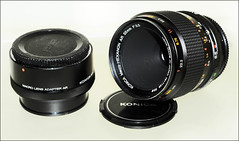
|
| Konica Macro-HEXANON AR 55mm F 3.5 by John Gateley (Image rights) |
- 50mm f1.8 Hexanon AR
- 50mm f1.7 Hexanon AR
- 50mm f1.4-16 and 50mm f1.4-22 Hexanon AR
- 52mm f1.8 Hexanon AR
- 57mm f1.4 Hexanon AR
- 57mm f1.2 Hexanon AR
- 58mm f1.2 Hexanon (AR?)
- 85mm f1.8 Hexanon AR
- 100mm f2.8 Hexanon AR
- 135mm f3.5-16 and 135mm f3.5-22 Hexanon AR
- 135mm f3.5 Hexar AR
- 135mm f3.2 Hexanon AR
- 135mm f2.5 Hexanon AR
- 200mm f3.5 Hexanon AR
- 200mm f3.5 Hexanon AR-P and AR-M
- 200mm f4 Hexanon AR
- 200mm f4 Hexar AR
- 200mm f5.6 Hexanon AR-P
- 300mm f4.5 Hexanon AR
- 300mm f6.3 Hexanon AR “Fluorite”
- 400mm f5.6 UC Hexanon AR
- 400mm f4.5-32 and 400mm f4.5-45 Hexanon AR-M
- 400mm f4.5-45 Hexanon AR-M
- 800mm f8 Hexanon AR-M
- 1000mm f8 Reflex Hexanon ARM
- 2000mm f11 Hexanon ARM
- 2X Hexanon Teleconverter
Zoom lenses
- 28-135mm f4-4.6 Hexanon AR
- 35-70mm f3.5 Hexanon AR
- 35-70mm f3.5-f4 Hexanon AR
- 35-70mm f4.0 Hexanon AR
- 35-100mm f2.8 Hexanon Varifocal AR
- 45-100mm f3.5 UC Hexanon AR
- 47-100mm f3.5 Hexanon AR-H
- 65-135mm f4 Hexanon AR
- 70-150mm f4 Hexanon AR
- 70-230mm f4.5 Hexanon AR
- 80-200mm f3.5 Hexanon AR
- 80-200mm f4 Hexanon AR
- 80-200mm f4 UC Hexanon AR
- 80-200mm f4.5 Hexanon AR
- 58-400mm f4 Hexanon AR
Macro lenses
- 55mm f3.5 Macro Hexanon AR and 1:1 Extension
- 105mm f4 Macro Hexanon AR and Auto Helicoid AR
Interchangeable lenses for 35mm rangefinder cameras
Konishiroku made a prototype interchangeable lens 35mm film rangefinder camera in the early 1960s — the Konica FR that utilized the Leica screw mount. However, that camera was never put into production. It wasn't until many years later with the Konica Hexar RF that they produced their own interchangeable lens rangefinder camera, this time using Leica M-Bayonet mount. The Hexar RF variants remain the only interchangeable lens rangefinder camera Konica/Konishiroku ever put into full production.
However, Konishiroku earlier produced a small range of standard lenses in Leica screw mount in the mid-1950s. Some manufacturers of Leica copies offered these lenses as original equipment fitted to their cameras, and others offered them optionally. In the 1990s, the Konica company also made a few lenses in Leica screw mount before the introduction of the Hexar RF.
- Leica 39mm screw mount lenses (LTM)

|
| Konica Hexanon 1:1.2 f=60mm (Image rights) |
- 1950s: see the main article on Konishiroku lenses in Leica screw mount
- Hexar 50mm f/3.5 (collapsible)
- Hexanon 50mm f/1.9
- Hexanon 60mm f/1.2
- various experimental or adapted lenses detailed in the main article
- 1950s: see the main article on Konishiroku lenses in Leica screw mount
- 1990s: see the main article on Konica lenses in Leica screw mount
- 35/2 Hexanon
- 35/2 UC-Hexanon
- 50/2.4 Hexanon (collapsible)
- 60/1.2 Hexanon
- 1990s: see the main article on Konica lenses in Leica screw mount
- Lenses for Hexar RF cameras: These lenses are also usable on any Leica M-bayonet compatible camera.
- 21-35mm f/3.4-4 M-Hexanon (dual focal length, not a zoom)
- 28mm f2.8 M-Hexanon
- 35mm f2.0 M-Hexanon
- 50mm f2.0 M-Hexanon
- 50mm f1.2 M-Hexanon
- 90mm f2.8 M-Hexanon
Interchangeable lenses for the Konica SF medium-format SLR
See Konica SF. This prototype 4.5x6 format camera and its lenses were never put into production.
- 50mm f/3.5 Hexanon
- 80mm f/2.8 Hexanon
- 135mm f/3.5 Hexanon
Other lenses were planned but never made: 35/4, 180/4.5, 250/5.6 and 500/8.
Interchangeable lenses for Koni-Omega Rapid cameras
- Koni-Omega Rapid
- Hexanon58mm f/5.6 (eight elements in four groups)
- Hexanon60mm f/5.6 (six elements in four groups)
- Hexanon90mm f/3.5 (four elements in three groups)
- Hexanon135mm f/3.5 (six elements in five groups)
- Hexanon180mm f/4.5 (five elements in four groups)
- Koni-Omegaflex
- Hexanon58mm f/5.6 (eight elements in four groups)
- Hexanon90mm f/3.5 (four elements in three groups)
- Hexanon135mm f/3.5 (six elements in five groups)(viewing lens has aperture ring as well)
- Hexanon180mm f/4.5 (five elements in four groups)
- The above are mounted as pairs in a lens board with a taking lens in shutter and a viewing lens without aperture control (the 135mm is an exception)
Barrel Lenses
- Hexanon GRII 150mm f/9
- Hexanon GRII 210mm f/9
- Hexanon GRII 260mm f/9
- Hexanon GRII 300mm f/9
Fixed lenses
- Hexar lenses
- Zion and Optor
- Hexanon lenses
- Konitor 75mm f/3.5 (three elements in three groups), on the Aram Six and some examples of the Pearl III
Accessory Items
Enlarging lenses
- Sakura Enlarging Lens 80mm f/6.3
- Sakura Enlarging Lens 135mm f/6.3[30]
- Konishiroku 50mm f/3.5 E-Hexanon enlarging lens
- Konishiroku 75mm f/4.5 E-Hexanon enlarging lens
Macro and close-Up, rangefinder and viewfinder cameras (fixed lens)
- Macro and copy set for Konica I
- Auto-Ups for various Konica camera
Macro and close-Up, 35mm SLRs, Bayonet Mount I (early)
- Konica Extension Rings
- Konica Macro Bellows (1)
- Konica Microscope Adapter
Macro and close-Up, 35mm SLRs, Bayonet Mount II (K/AR)
- Konica Extension Rings AR
- Konica Macro Bellows II
- Konica Macro Bellows IIB
- Konica Macro Bellows 2 AR
- Konica Slide Copier 2 AR
- Konica Macro Stand
- Konica Macro Auto Bellows AR
- Konica Macro Auto Ring
- Konica Double Cable Release
- Konica Electronic Dual Cable Switch
- Konica Close-Up Diopter Lenses
- Konica Microscope Adapter AR
Flash: bulb holder & electronic types
- Cherry Flash (bulb holder type, for RF & VF cameras)
- Koniflash (bulb holder type, rangefinder cameras)
- Koniflash II (bulb holder type, rangefinder cameras)
- Koniflash III (bulb holder type, rangefinder and SLR cameras)
- Koniflash IIIM (1st hot shoe type, bulb holder, rangefinder & SLR cameras)
- Konica Flash ((bulb holder type, primarily for SLR cameras)
- Konica Cube Flash (uses standard flash cubes, primarily for rangefinder cameras, black and chrome versions)
- Konica X14 Flash
- Konica X18 Flash
- Konica X20 Flash (black and chrome versions)
- Konica X20N Flash
- Konica X24 Flash
- Konica X28 Flash
- Konica X36 Flash
- Konica Cold Shoe Accessories
- Konica Hot Shoe Accessories
35mm slide projectors
- Konislide Projector
Other accessories
- Sakura rollfilm holder
- Konihoods
- Konifilters
- Konicameter (for meterless rangefinder cameras)
- Konicameter LV (for meterless rangefinder cameras)
- Koni Meter (for FP, mounts atop pentaprism)
- Koni Meter II (for FP, mounts in front of shutter speed dial)
- Koni Meter III (for Auto-Reflex P/Autorex P)
- Konica Angle Finder AR
- Konica Magnifier AR
- Konica MagniFinder AR
- Konica Winder AR (for T4)
- Konica Winder F (for FC-1 and FP-1)
- Konica Lefthand Shutter Release (for electronic SLR models)
- Konica Bulk Film Loader
- Konica Film Leader Retriever
Lens adapters
Both in the early F mount and the later K/AR mount, Konishiroku and third parties offered a number of lens adapters to allow other manufacturers' lenses to be used on Konica cameras. The following Konishiroku-made adapters are known:
- Exakta lens to Konica Bayonet Mount (F)
- Nikon F mount lens to Konica Bayonet Mount (F)
- Konica Bayonet Mount I (F) to Konica Bayonet Mount II (K/AR)
- Exakta lens to Konica Bayonet Mount II (K/AR)
- Nikon F mount lens to Konica Bayonet Mount II (K/AR)
- Practica lens (M42 screwmount) to Konica Bayonet Mount II (K/AR)
Note 1: Konica 35mm SLRs were designed with a shorter than usual lens to film register, which means the distance from the lens mount to the film plane is less than most other SLR cameras. This allowed a great many other manufacturers' lenses to be easily adapted without the need for additional optical elements. The shallow register allows room for an adapter to be fitted. It is believed that this design feature was deliberate.
Unfortunately, it also means that Konica lenses are not easily adapted to other cameras. Their design generally means that to fit other manufacturers' cameras with full functionality any adapter would require additional, corrective optics. Few such adapters are known to have been made. Lower quality optics in any adapter will compromise image quality, while higher quality optics generally make an adapter costly.
Alternatively, a Konica lens fitted to another manufacturer's camera using an adapter that lacks any additional optics will generally lose the ability to focus to infinity (but gain close focusing ability). This is much the same as adding a macro extension tube behind a lens because the adapter moves the lens further from the film plane.
There is rumor of a Konica lens (K/AR) to Nikon F adapter, perhaps made by a third party manufacturer. This would include a corrective optical element. Any additional information would be appreciated.
Note 2: The Nikon F mount lens to Konica Bayonet Mount II (K/AR) adapter was and is the most sought after and priciest of the Konishiroku-made adapters. This was and perhaps still is because when Nikon introduced their PC (Perspective Control) Nikkor lenses it was found that none of the Nikon cameras could meter accurately through the lens (TTL) while the lens was shifted. It was necessary to re-center the lens, meter, then reset the shift. Someone discovered that - via the Nikon-Konica adapter - Konica camera bodies metered accurately with the lens shifted. News spread quickly and many Nikon users in the 1970s who wanted to use the PC lenses also kept a Konica T"2" or T3 camera body on hand for just this reason. Even thirty plus years later this particular adapter often still sells for 5 or 10 times what the others do.
Leaf shutters
- Apus
- Zeus and Durax
- Pegasus, on the Pearlette
- Echo, on the Pearlette
- Rox, on the Baby Pearl
Special and Military Items
- Konica I "US Signal Corp." special (post WWII)
- Navy Type 89 Machine-gun Camera (WWII)
- Aerial Cameras, various models, incl.
- Konishiroku GSK-99 Aerial Camera
- Konishiroku SK-100 Aerial Camera
- Konica Type G Aerial Camera
- Konishiroku and Rokuoh-Sha Aerial Camera Lenses
- Konica MS-40 (variant of Genba Kantoku/Off Road)
- X-Ray Camera (Rubicon)
- X-Ray Film
- Repro Lenses
Film and chemistry
For a listing of photographic film, paper and chemical products see Konica film.
The company was an important producer of film and photographic chemistry from the beginning of the XXth century.
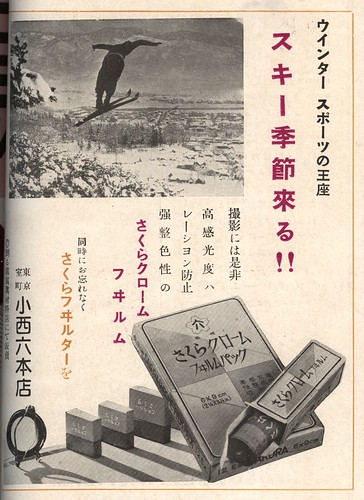
|
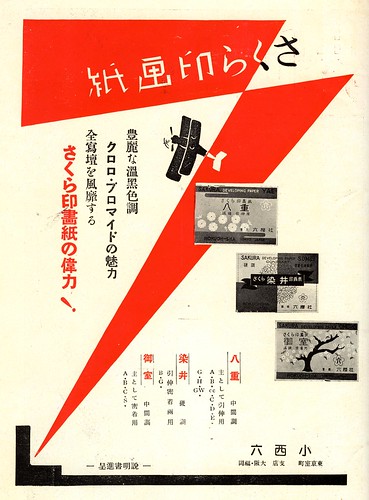
|
| Advertisement for Sakura Chrome film and Sakura filters in Shashin Salon January 1934. (Image rights) | Advertisement for Sakura paper in Camera Club December 1937. (Image rights) |
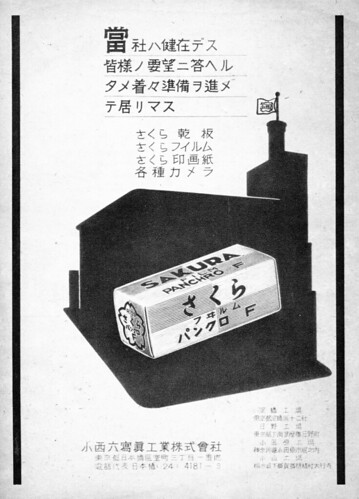
|
| Advertisement for Sakura Panchro film in Ars Camera January 1946. This is the earliest postwar advertisement by Konishiroku. (Image rights) |
Imported products
Konishiroku imported various foreign products, at least until World War II.
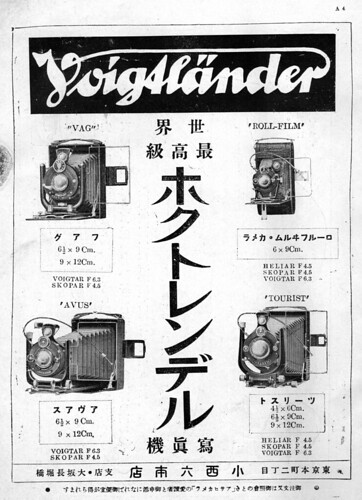
|
| Advertisement in Asahi Camera February 1930, for Voigtländer cameras imported by Konishiroku Honten. (Image rights) |
Notes
- ↑ Kamei, p.6 of Kurashikku Kamera Senka no.10, Shibano, p.90 of the same, and a page formerly published at the R. Konishi Rokuoh-sha website.
- ↑ Kamei, p.6 of Kurashikku Kamera Senka no.10; Shibano, p.90 of the same.
- ↑ Kamei, p.6 of Kurashikku Kamera Senka no.10; Shibano, p.90 of the same.
- ↑ Sakai, p.10 of Kurashikku Kamera Senka no.10.
- ↑ Kamei, p.6 of Kurashikku Kamera Senka no.10, and a page formerly published at the R. Konishi Rokuoh-sha website.
- ↑ Sakai, p.10 of Kurashikku Kamera Senka no.10. More details are found in this page of the R. Konishi Rokuoh-sha website.
- ↑ Kamei, p.6 of Kurashikku Kamera Senka no.10.
- ↑ Pearlette supervised by Yamada Kōgorō: Kamei, p.6 of Kurashikku Kamera Senka no.10.
- ↑ Kamei, p.7 of Kurashikku Kamera Senka no.10.
- ↑ Shibano, p.90 of Kurashikku Kamera Senka no.10.
- ↑ Its address in 1943 was Tōkyō-to Yodobashi-ku Jū-ni-sha 320 (東京都淀橋区十二社320). Source: "Kokusan shashinki no genjōchōsa" ("Inquiry into Japanese cameras"), listing the Japanese camera production as of April 1943.
- ↑ The structure of the name "Konishiroku" (小西六) is ko (小) - nishi (西) - roku (六): nishi within it (meaning "west") is indivisible. (Ni is no more meaningful an abbreviation of nishi than "we" is of "west".) Thus the new name does not "make sense".
- ↑ 13.0 13.1 Company profile of Konica Minolta Electronics.
- ↑ on Oct. 21 1987: 'Konishiroku changes name to Konica ' PR Newswire, 1987 Oct 21, p.LA53
- ↑ On April 25, 1984. 'Konishiroku Photo Ind. U.S.A. to be renamed Konica U.S.A., Inc. ' PR Newswire, 1984 April 25, NYPR79
- ↑ Product Code: BY-72015
- ↑ Product Code: BY-36152 (blue box); BY-38986 (purple box)
- ↑ Product Codes: BY-52016; BY-92438
- ↑ Product Code: BY-38985
- ↑ Konica product leaflet for Centuria Super Flash 800 (archived)
- ↑ Annual production about 500,000 units (Product Recall Notice) (archived)
- ↑ Annual production about 500,000 units (Product Recall Notice) (archived)
- ↑ recall due to faulty Sony battery for flash (April 2022, page no longer available)
- ↑ recall due to faulty Sony battery for flash (April 2022, page no longer available)
- ↑ Hosaka Takao, Mizoguchi Shuri, Nakanishi Hiromi, Yogata Kozue and Kogo Shoji, ‘The Development of the Torikkiri Konica MiNi Goody and Torikkiri Konica MiNi Goody SUPER Single-Use Cameras.’ Konica Tech Report 14, pp. 17-20, 2001
- ↑ Hosaka Takao, Mizoguchi Shuri, Nakanishi Hiromi, Yogata Kozue and Kogo Shoji, ‘The Development of the Torikkiri Konica MiNi Goody and Torikkiri Konica MiNi Goody SUPER Single-Use Cameras.’ Konica Tech Report 14, pp. 17-20, 2001
- ↑ Yoshida Kojiro, Kuzuhara Takeshi, Masuda Takuro, Yogata Kozue, and Kogo Shoji, ‘The Development of the Torikkiri Konica MiNi Wai Wai Wide Single-Use Camera.’ Konica Tech Report 16, pp. 31-34, 2003
- ↑ See this video: http://www.youtube.com/watch?v=MwnP8Yz4fWE
- ↑ 29.00 29.01 29.02 29.03 29.04 29.05 29.06 29.07 29.08 29.09 29.10 29.11 29.12 Formerly published on a history page of the Rokuoh-Sha website.
- ↑ See this page of the Tōkachi Banbetsu blog.
Bibliography
Original documents
- Ars Camera. Advertisements by Konishiroku Shashin Kōgyō:
- January 1946, p.33;
- February 1946, p.42;
- April 1946, p.42;
- May 1946, p.42;
- July 1946, p.42.
- Asahi Camera. Advertisement by Konishiroku Honten in February 1930, p.A4.
- Camera Club. Advertisement by Konishiroku in December 1937, between pp.24 and 25.
- "Kokusan shashinki no genjōchōsa" (国産写真機ノ現状調査, Inquiry into Japanese cameras), listing Japanese camera production as of April 1943. Reproduced in Supuringu kamera de ikou: Zen 69 kishu no shōkai to tsukaikata (スプリングカメラでいこう: 全69機種の紹介と使い方, Let's try spring cameras: Presentation and use of 69 machines). Tokyo: Shashinkogyo Syuppan-sha, 2004. ISBN 4-87956-072-3. Pp.180–7.
- Shashin Salon. Advertisement by Konishiroku Honten in January 1934, no page number.
Recent sources
- Baird, John R. The Japanese Camera. Yakima, WA: Historical Camera Publications, 1990. ISBN 1-879561-02-6.
- Kamei Takeshi (亀井武). "Konishiroku ryakushi" (小西六略史, Abridged history of Konishiroku). Kamera Rebyū: Kurashikku Kamera Senka (カメラレビュー クラシックカメラ専科) / Camera Review: All about Historical Cameras no.10, September 1987. No ISBN number. Konishiroku kamera no rekishi (小西六カメラの歴史, special issue on Konishiroku). Pp.6–7.
- Sakai Shūichi (酒井修一). "'Anbako' kara 'ōtofōkasu' he: kamera no hensen to tomo ni ayunda 114-nen" (「暗函」から「オートフォーカス」へ・カメラの変遷と共に歩んだ114年, From 'camera obscura' to 'autofocus': 114 years of camera evolution). Kamera Rebyū: Kurashikku Kamera Senka (カメラレビュー クラシックカメラ専科) / Camera Review: All about Historical Cameras no.10, September 1987. No ISBN number. Konishiroku kamera no rekishi (小西六カメラの歴史, special issue on Konishiroku). Pp.8–13.
- Shibano Daisuke (柴野大輔). "Konishiroku seishiki tenmei-shamei no hensen ichiran-hyō" (小西六正式店名・社名の変遷一覧表, Evolution of the Konishiroku official company name). Kamera Rebyū: Kurashikku Kamera Senka (カメラレビュー クラシックカメラ専科) / Camera Review: All about Historical Cameras no.10, September 1987. No ISBN number. Konishiroku kamera no rekishi (小西六カメラの歴史, special issue on Konishiroku). Pp.90–1.
Links
In English:
- Document with a brief chronology of Konica, available in pdf at the Konica Minolta official site
- Survey of Konica SLR cameras
- Konica SLR site at buhla.de
- Konica disc camera page at The Sub Club
- Konica instruction manuals, color, mostly English, PDF format, from OrphanCameras.com
- Urs Brunner's Konica Collector website, includes online insturction manuals, advertisements, images of many models and more.
- Hexanon & Hexar User Group on Flickr is intended to show off the capabilities of Konica lenses and cameras of all vintages and types.
- Konica cameras price guide at collectiblend.com
In French:
- Konica page at Collection G. Even's site
- Cameras at www.collection-appareils.fr
- Le système reflex Konica (archived)
In Japanese:


